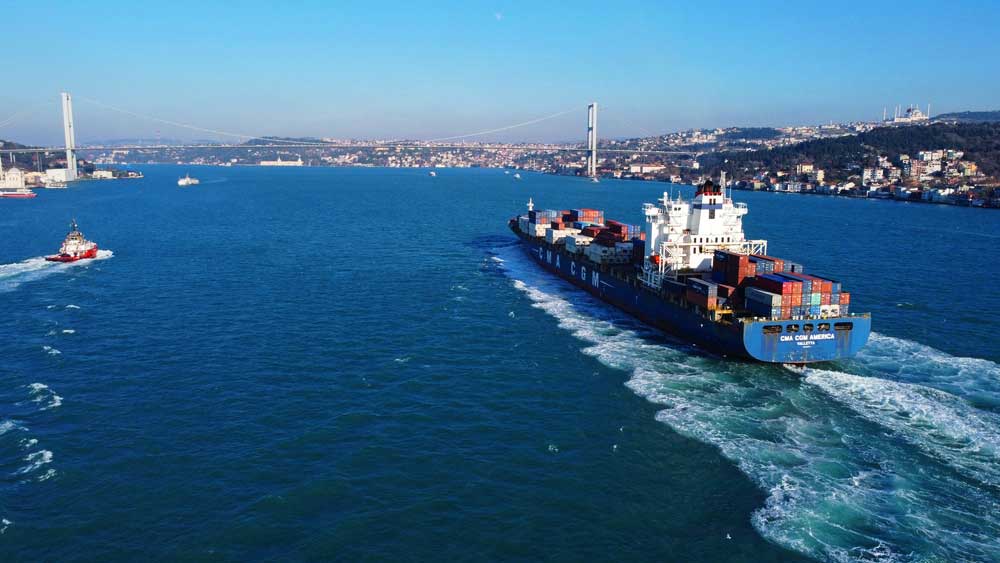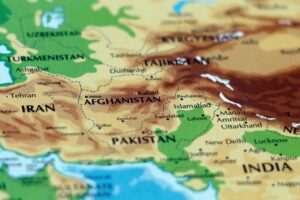Russia’s attack on Ukraine in February 2022 drew attention to shifting geopolitics in the region and heightened the importance of maritime security in the Black Sea. Tensions in Ukraine had escalated when Russia invaded and annexed Crimea in 2014, and continued with insurgencies and proxy warfare in the Donbas region thereafter. Hostilities reached a climax when Russia launched a military operation in 2022 to subdue the government in Kiev and annul its long-running bid to join the NATO alliance. Apart from the land front, however, there is an important maritime component to the wider conflict that involves reprisals between Russia and NATO member states since 2021. Earlier in June 2021, another flashpoint near Crimea involving the British warship HMS Defender and Russian forces also underscored the political salience of maritime security for the region. The warship, part of a NATO naval task force participating in Operation Sea Guardian for counter-terrorism missions, was harassed by Russian aircraft and coastguard vessels a short distance away from the Crimean Peninsula as it passed through Ukrainian territorial waters.[i] The deep-water port of Sevastopol in Crimea is the main naval facility of Russia – a crucial enabler of its activist posture that serves as a springboard for rotations to and from the Syrian port of Tartus. Several months later, the region drew attention in December 2021 due to rising tensions between Ukraine and Russia and the latter’s alleged preparations for an impending invasion. In a major maritime escalation, Russia effectively applied a naval blockade on Odessa in southern Ukraine to compel the Kyiv government to officially rule out its future NATO membership.[ii] Lastly, Russia’s recognition of the independence of the People’s Republics of Donetsk and Luhansk and the pre-emptive strike on Ukraine in February 2022 marked what some analysts label as “the end of the post-Cold War era”.[iii]
Apart from the land front, there is an important maritime component to the wider conflict that involves reprisals between Russia and NATO member states since 2021.
At the heart of the wider geopolitical conflict is the quest for maritime control in the Black Sea and passage rights to and from the Aegean Sea through the Turkish Straits. The Montreux Convention (1936) governs the regime of the Bosphorus and Dardanelles Straits in Turkey and regulates the passage of ships. While guaranteeing free transit of commercial vessels at peacetime, it restricts the number, displacement, and transit time of naval vessels in both war and peace time. The applicable criteria for passage rights are based on a flag-bearer ship’s home nation. The convention prohibits the presence of naval vessels from non-riparian states in the Black Sea, such as the US and the UK, for over twenty-one days. It grants Turkey the contingency to close the straits in times of war or threat of war, and places restrictions on navies of belligerent states that may transit through the straits during war time.
NATO defense doctrine delimited Turkey’s maritime coverage to only the Black Sea. Instead, it appointed Greece to cover the Aegean Sea and the Eastern Mediterranean, mainly because the Greek islands could act as a secondary defense ring.
To elaborate on the significance of the Turkish Straits for the regional balance of power, it is essential to take a historical perspective and highlight that the Montreux Convention is a key element of the strategic environment in the Black Sea today. Its goal is to preserve stability in the region and prevent the upsetting of “the delicate equilibrium and spirit of cooperation” among the littorals.[iv] Signed at an international conference in July 1936 among Turkey and nine other states, including Britain, France, Greece, and the Soviet Union, the convention survived great power rivalries between the 1930s and the 1990s, and sustained the Turkish position of “active neutrality” to fend off pressure from both the Axis and Allied powers to enter World War II.[v] Turkish Straits gated the only warm-water entrance for the USSR to reach the Atlantic Ocean, and Russians repeatedly demanded “joint control of the Straits” in 1945-1946, which, according to the Truman administration in Washington, “reflected a desire to control and dominate Turkey”.[vi] Ankara balanced Russia’s alleged designs on the straits through membership in NATO in 1952, and, crucially, NATO defense doctrine delimited Turkey’s maritime coverage to only the Black Sea. Instead, it appointed Greece to cover the Aegean Sea and the Eastern Mediterranean, mainly because the Greek islands could act as a secondary defense ring and block Soviet access to the Mediterranean if Turkey fell to the USSR. Turkey applied an A2/AD (anti-access, area-denial) strategy for total sea-control against the Soviet Union and a possible Warsaw Pact incursion from the north but also kept strict observance of the Montreux regime by denying access to NATO submarines and aircraft carriers through the straits. Many Turkish defense analysts herald the Montreux Convention as a landmark diplomatic achievement for maritime control that enabled Turkey to navigate a delicate balance during the Cold War and “prevented the Black Sea from becoming another Persian Gulf”.[vii]
After the Cold War, the relatively stable strategic environment in the Black Sea began to change in the early-to-mid 2000s due to a resurgent Russia, an expanding NATO, and an activist Turkey. Turkey took the initiative in 2004 to set up BLACKSEAFOR with Russia, Ukraine, Bulgaria, Romania, and Georgia to enhance cooperation among littoral navies and promote stability in the Black Sea.[viii] Although the Black Sea task force has been suspended since 2015 due to the crisis in Ukraine and tensions with Russia, the associated Operation Black Sea Harmony launched in 2004 – with its HQ located in Ereğli, Turkey – to contribute to maritime security in the Black Sea continues, at least on paper.[ix] Over the years, Turkey also expanded its presence in the Mediterranean Sea via Operation Active Endeavour and Operation Peace Shield naval missions. These important initiatives reflect Turkey’s interest to find a new regional balance between NATO and Russia after the Cold War to keep control over its “strategic backyard” in the Black Sea.[x]
Notably, the Turkish Straits gate the entrance to the Black Sea’s strategic ports and rich sources of hydrocarbons that carry the potential to transform the region into a potential maritime flashpoint much like the Persian Gulf. The Black Sea is a transport and power projection artery through which 60% of Russian trade passes each year. It is also a major export route for oil and gas. From the West’s perspective, Russia’s annexation of Crimea in 2014, the monopolisation of energy supply routes to Europe, and the recent assault on Ukraine have ultimately resulted in the energy consumers of the industrialised world to seriously consider pursuing hydrocarbon alternatives.[xi] The geopolitical rivalry to control waters of the wider region at times of uncertainty and the need to maintain navigation rights through critical chokepoints are illustrative of Turkey’s pivotal role in the region. As the world focused on Turkey’s response to the crisis in Ukraine, maritime diplomacy became a litmus test of Ankara’s larger geostrategic orientation regarding the West/NATO and Russia. On 28th of February 2022, Turkish Foreign Minister Mevlüt Çavuşoğlu announced the closure of the Dardanelles and Bosphorus Straits to belligerent powers based on the rights/obligations granted to Turkey under Article 19 of the Montreux Convention and Ankara’s assessment that the conflict between the two countries turned into a full-fledged war.[xii] The article stipulates that “vessels of war belonging to belligerent Powers shall not pass through the Straits”.[xiii] Turkish Defense Minister Hulusi Akar’s statement in parallel that “Turkey will continue to apply Articles 19, 20, 21” confirmed that Ankara has invoked the convention to limit passage of warships[xiv] both ways and demanded all parties not to send their naval units to the region to help de-escalate tensions.
By carefully applying the Montreux Convention, Turkey positioned itself as a non-belligerent balancer between the Middle East, NATO, and Russia.
The straits also form a key pillar of Turkey’s new maritime defence concept called “Blue Homeland” that aims to maintain the status quo and not to provoke Russia with alleged designs to alter the Black Sea’s status. In February 2021, former Supreme Allied Command Europe (SACEUR) Commander Gen. (Ret.) Philip Breedlove suggested Turkey lead a NATO standing naval task force in the Black Sea to demonstrate its leadership; this would be a “confidence-building measure,” he said.[xv] Clearly, the United States wants Turkey to revert to the Cold War paradigm of sea denial/control in the Black Sea and abandon the initiative in the Aegean and the Mediterranean, once again, to Greece and Cyprus. However, Russian President Vladimir Putin expressed Moscow’s sensitivity about the Montreux regime on a phone call to his Turkish counterpart, President Recep Tayyip Erdoğan, in that same month, stressing the “importance of preserving the Montreux Convention Regarding the Regime of the Straits with a view to ensuring regional stability and security”.[xvi] Erdoğan confirmed in a press statement that “Turkey abides by Montreux until it finds a better alternative”.[xvii] The turnout of the crisis in Ukraine suggests that, by carefully applying the Montreux Convention, Turkey positioned itself as a non-belligerent balancer between the Middle East, NATO, and Russia, prioritising stability over adventurous foreign expeditions. NATO’s strategy is to expand its presence in the Black Sea and to limit Russia’s manoeuvrability, but since large ships are of little value in a small, enclosed area like the Black Sea, and foreign aircraft carriers are prohibited under the Montreux Convention, NATO demands Turkey to put forward its own submarines for A2/AD missions. Amid the war in Ukraine, Turkey is treading a fine line of balance between NATO and Moscow and any strategic shift to engage with Russia in an unstable Black Sea would take away from Turkey’s commitment to maintaining the balance against Greece and Cyprus in the Aegean Sea/Eastern Mediterranean.
Turkey is seeking to distribute geopolitical risk among its trade partners in the West, Middle East, and Eurasia by not joining western sanctions against Russia, keeping its airspace open to Russian civilian aircraft, and mending ties with its former foes in the Middle East – Israel, the UAE, Saudi Arabia, and Egypt. Therefore, anticipated repercussions of a potential NATO-Russia confrontation in the Black Sea makes Turkey think twice. Russia is increasingly acting as an assertive and resurgent power in Europe and elsewhere, but Turkey does not want to run into a showdown with its overbearing northern neighbour. Although Ankara provides military assistance to Kyiv as a means of mending fences with Washington/NATO, it is acutely aware of the risks involved in a conflict scenario where it might be dragged into an unintended hot incident with Russia over the latter’s retaliation to NATO’s presence/support in Ukraine. Turkey would be on the receiving end of collateral damages in the event of a major fallout with Russia, and Ankara tries to avoid a situation where it is left out in the dark having to manage a crisis over navigation rights in the Turkish Straits. This bleak scenario might put Ankara under intense pressure to back Turkey’s NATO allies in concerted action against Russia in the future and further restrain the Turkish economy already sailing through dire straits. It would also be the end of Turkey’s intended position as a regional power and a delicate rebalancer in the new equilibrium between NATO and Russia.
Ankara re-evaluates its strategic commitment to the NATO alliance, diversifies its partnerships for security reassurance, and tries to steer away from active engagement with Russia on a war front.
In summary, Turkish Straits and the Black Sea are heightened in importance due to shifting regional geopolitics, the recent crisis in Ukraine, and energy security concerns in Europe. The Black Sea has become the battleground of great power rivalry and proxy warfare in a multipolar world where state actors vie for security and/or regional influence through defensive/offensive means. Ankara re-evaluates its strategic commitment to the NATO alliance, diversifies its partnerships for security reassurance, and tries to steer away from active engagement with Russia on a war front. Despite its foreign policy activism and recent military interventions abroad, Turkey applies active neutrality to maintain the status quo of the Montreux regime and to keep its strategic backyard open and accessible for peaceful purposes in a “balance of threat” strategy.
[i] Dmitry Gorenburg, “The HMS Defender Incident: What Happened and What Are the Political Ramifications? | Russia Matters,” Russia Matters (blog), July 1, 2021, https://russiamatters.org/analysis/hms-defender-incident-what-happened-and-what-are-political-ramifications.
[ii] Peter Dickinson, “Black Sea Blockade: Ukraine Accuses Russia of Major Maritime Escalation,” Atlantic Council (blog), February 10, 2022, https://www.atlanticcouncil.org/blogs/ukrainealert/black-sea-blockade-ukraine-accuses-russia-of-major-maritime-escalation/.
[iii] Robin Wright, “Does the U.S.-Russia Crisis Over Ukraine Prove That the Cold War Never Ended?,” The New Yorker, February 19, 2022, https://www.newyorker.com/news/daily-comment/does-the-us-russia-crisis-over-ukraine-prove-that-the-cold-war-never-ended.
[iv] Cem Gürdeniz int, Interview with Cem Gürdeniz, August 17, 2021.
[v] Selim Deringil, Turkish Foreign Policy During the Second World War: An “Active” Neutrality (Cambridge University Press, 1989).
[vi] Jonathan Knight, “American Statecraft and the 1946 Black Sea Straits Controversy,” Political Science Quarterly 90, no. 3 (1975): 451, https://doi.org/10.2307/2148296.
[vii] Gürdeniz int, Interview with Cem Gürdeniz.
[viii] MOD Russian Federation, “Exercise of the Black Sea Naval Force (BLACKSEAFOR): Ministry of Defense of the Russian Federation,” 2021, https://eng.mil.ru/en/mission/practice/more.htm?id=10578603@cmsArticle.
[ix] Turkish Navy, “Turkish Naval Forces • Operation Black Sea Harmony,” 2021, https://www.dzkk.tsk.tr/en-US/Harekat/Content/operation-black-sea-harmony.
[x] Gürdeniz int, Interview with Cem Gürdeniz.
[xi] Serhat S. Çubukçuoğlu, “Turkey’s Exclusive Economic Zone in the Mediterranean Sea: The Case of Kastellorizo” (Medford, MA, The Fletcher School of Law and Diplomacy, Tufts University, 2014).
[xii] Tayfun Ozberk, “Turkey Closes the Dardanelles and Bosphorus to Warships,” Naval News (blog), February 28, 2022, https://www.navalnews.com/naval-news/2022/02/turkey-closes-the-dardanelles-and-bosphorus-to-warships/.
[xiii] UN Conventions, “Convention Regarding the Régime of Straits” (United Nations, December 11, 1936), https://treaties.un.org/pages/showDetails.aspx?objid=0800000280166981.
[xiv] odatv4.com, “Son Dakika… Hulusi Akar’dan Montrö açıklaması,” Oda TV (blog), March 1, 2022, https://www.odatv4.com//guncel/son-dakika-hulusi-akar-dan-montro-aciklamasi-231144.
[xv] H.E. General Philip Breedlove (Ret.), “Turkish Heritage Organization: U.S. Foreign Policy under the Biden Administration: Challenges and Changes” (Washington D.C, US, February 25, 2021).
[xvi] Team of the Official Website of the President of Russia, “Telephone Conversation with President of Turkey Recep Tayyip Erdogan,” President of Russia, April 9, 2021, http://en.kremlin.ru/events/president/news/65338.
[xvii] BBC News Türkçe, “Cumhurbaşkanı Erdoğan: Daha iyisi için imkân bulana kadar Montrö’ye bağlılığımızı sürdürüyoruz,” BBC News Türkçe, April 6, 2021, https://www.bbc.com/turkce/haberler-turkiye-56640091.















